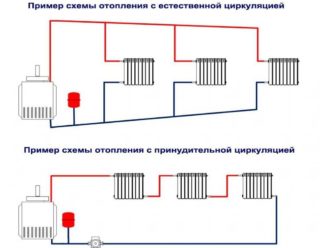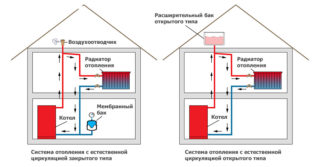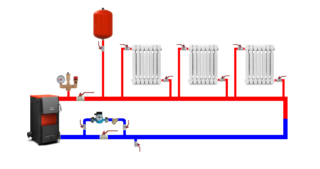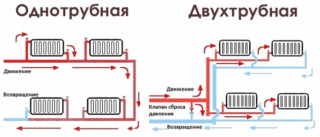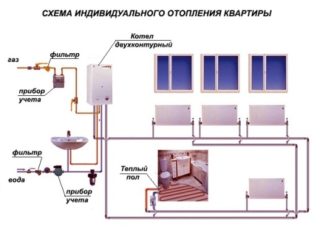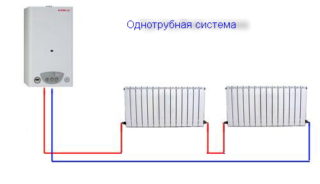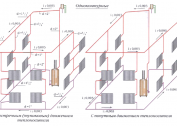Arrangements for arranging the heating system in a private house are classified as procedures for which a certain level of training is required from the contractor. Do-it-yourself installation of heating is a competent approach to choosing the right boiler model and the correct calculation of its power. In addition, during its implementation, engineering communications will be required to ensure a continuous operation of the heating unit.
Prerequisites for installation
Before proceeding with the installation of heating in a private house, it is important to understand the features of the upcoming operations and the conditions under which it is permissible to conduct them. Requirements considered mandatory when installing the heating system:
- the presence in the country house of a separate room designed specifically for the placement of boiler equipment and control equipment with automation;
- the possibility of arranging an effective ventilation system, without which the safe functioning of heating units is impossible;
- admissibility of organizing a separate branch from the water supply line, used exclusively for the purposes of hot water supply and heating.
For the placement of heating equipment is strictly prohibited the use of living spaces (kitchens and other utility rooms).
The correct approach to compliance with safety requirements provides for mandatory grounding of the boiler body. In a private house, you will need to make a remote protective circuit.
Types of coolant circulation
In accordance with the principle of moving the coolant, which is used to heat private houses, all systems are divided into two types - with natural and forced circulation. In apartment buildings, the first of these options is widely used, when the water carrier moves by gravity. This becomes possible due to the different densities of the heated and cooled layers of the liquid when the warm parts are replaced by cold ones.
When designing heating for a summer residence or suburban building, where the system is isolated from other consumers, it is practically impossible to do without forced circulation.
Natural circulation
In a system with a liquid coolant moving by gravity, the heated water has a lower density and, being in a closed volume, is gradually squeezed out by cold layers. For its movement, even vertical sections of the heating distribution are not an obstacle.
The coolant heated in the boiler flows by gravity to the installed radiators, transfers heat through exchange with the surrounding air, and then returns to the boiler. Over time, this cycle repeats, thereby supporting the natural circulation process. To ensure it, the system provides for small specifications:
- Horizontal sections, like sewage, are made with a slight slope towards the movement of the coolant - not more than 3 cm per meter
- The boiler is located as low as possible relative to the horizon, which increases the pressure difference - the principle of communicating vessels is triggered;
- The riser and collector pipes with hot water are made of a larger diameter.
- The heat conduit route itself is laid as far as possible in straight sections, the number of turns in which is minimal.
Installation of heating systems is organized using pipes made of materials that have a minimum resistance to flow - from polypropylene or, in extreme cases, steel.The disadvantages of natural circulation are incomparably greater, which is the flip side of the simplicity of the device.
Characteristic disadvantages:
- this method is effective only in buildings of limited size - an area of not more than 100 square meters. meters with a total pipe length of about 30 meters;
- low speed of heating the premises;
- the complexity of calculating the required power and the need to use an open tank instead of an expansion tank;
- continuous evaporation of the liquid, the reserves of which have to be replenished all the time.
These shortcomings are the reason that the systems of natural circulation in private homes are practically not installed.
Forced circulation systems
A mandatory element of such schemes is a liquid pressure pump. It is built into the return wiring pipe, through which the cooled coolant returns, or is installed directly in the boiler. To extend its service life, a cleaning filter is installed in the pipe. The benefits of forced circulation include:
- there is no need to organize a special bias;
- fluid flow rate through polypropylene pipes;
- uniformity of heating of the surrounding space;
- aesthetics of a system of pipes of the same diameter.
There are no restrictions on the length of the pipeline. With its increase, it is enough to put a more powerful pump.
There are practically no drawbacks to this method of organizing the circulation, except for the significant costs of the arrangement.
Types of systems
Before you start installing the heating system in the house, you will need to learn how to distinguish between a single-pipe and a two-pipe method of arranging it. In the first case, wiring from one pipe is used, which forms a closed circuit with a coolant circulating through it. A sequential scheme is implemented, according to which the water carrier, passing through the boiler, heats up, after which it transfers heat to the radiators. At the final stage of his movement, he, already cooled, again enters the solid fuel boiler.
The double-circuit system is more complicated, as it consists of two separate branches, each of which performs its own function. The first of them is designed to transfer heat from the boiler to the radiators, and the second - to remove the cooled coolant back to the boiler unit.
The choice of wiring option is determined by the preferences and financial capabilities of the owner of the house, since the arrangement of a 2-pipe system is associated with high costs.
Self-assembly methods
When choosing a heating system for a private house, preference is given to the option of forced circulation of a coolant that can evenly heat large spaces. For the same purpose, the wiring is chosen more complex (dual-circuit), which guarantees good heat transfer and the absence of problems with the movement of fluid through the pipe system.
A similar approach to the independent arrangement of the heating system is also observed in the country cottage, where there are even more areas allocated for housing. If there are 2 or 3 floors in such a building, you should calculate in advance the boiler capacity, which would be enough for all household needs.
For unheated small apartments in urban houses, the most optimal option is a dual-circuit system with natural coolant circulation. Only such an approach to the organization of heating in multi-unit housing allows you to connect to existing water mains.
The nuances of water heating
Installation of heating and all associated equipment is carried out using a variety of methods, including combined switching. In addition to the classification already considered, many other wiring schemes for private households are known:
- single pipe horizontal (vertical) connection;
- Leningradka
- two-pipe scheme with lower eyeliner;
- two-pipe scheme with the upper wiring;
- radiation system using collectors.
Which of these methods is most suitable for a private home is up to the user to decide. To do this, you must carefully familiarize yourself with all the advantages and disadvantages of various methods of installing heating boilers.

